| Construction Rating: | starstarstarstarstar_border |
| Flight Rating: | starstarstarstarstar |
| Overall Rating: | starstarstarstarstar_border |
| Diameter: | 1.33 inches |
| Length: | 21.00 inches |
| Manufacturer: | Red River Rocketry  |
| Style: | Futuristic/Exotic |

(Contributed - by John Lee - 11/15/09)
Brief:
The USS Prometheus is a futuristic freighter designed to work on 18mm motors. I would call it a skill level 2 kit.
There is some cutting of tubes and some alignment issues but the fins are die cut. It also uses a combination or
white/yellow glue and epoxy with a few methods that are not seen in many simple kits.
Construction:
Construction begins with the motor mount. The first item is to make a mark for the engine hook but, instead to
telling you to measure back some distance, the instructions take the practical route of saying to set the thrust ring
alongside the motor tube to place the mark.
Dimensions were then given to make marks for the centering rings. A slit was then made for the engine hook and the hook was inserted. Some electrical tape was used to hold the engine hook in place and the rear centering ring was slid into place and glued with yellow glue. It was allowed to sit a bit and then the forward ring was likewise placed.
While the first round of glue on the rings was setting up, the thrust ring was glued into to forward end of the motor tube flush with the end of the engine hook. A light fillet of yellow glue was then placed on both sides of both centering rings.
When these fillets had dried, I tied a Kevlar® harness around the forward end of the motor mount and laid down a heavier fillet on top of it and on the other joints of the motor mount. This was allowed to dry thoroughly.
I should point out here that the Kevlar® harness is a modification on my part. When dry, glue was swabbed into the body tube and the motor mount was inserted. A swab was then used to build up a fillet around the aft centering ring.
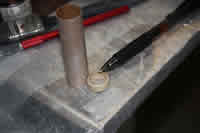

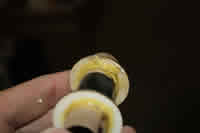
The fins for the Prometheus were all precut and were still held captive in their parent stock. I gently sanded
both sides before removing the pieces. The main fins/wings are built up out of 2 pieces. I used a double glue joint to
join the pieces and a steel ruler to make sure the root edges stayed aligned.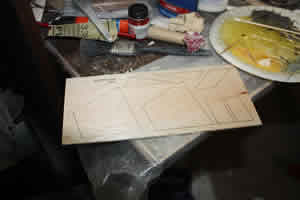
As the main part of the fins were drying, I turned to the other balsa pieces which included the vertical tail and two more pieces to be fitted to the ends of the wings to support the nacelles. This balsa too was of good quality and I used the opportunity to round the leading and trailing edges, being careful not to mar the root or outer edges; those would need to remain flat for other joints.
The drying time was also to mark the proper lines on the body tube. The kit came with a wrap around fin guide which was cut out and taped around the body. The lug line was aligned with the engine hook and then all of the lines were transferred. The guide was removed and an angle was used to extend the lines.
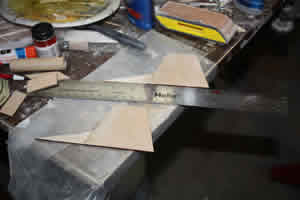
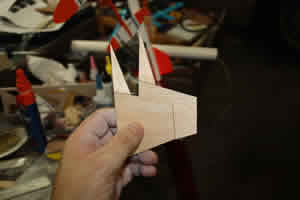
I considered the main part of the fins to be dry enough to mess with again the next day. Looking them over, the joint seemed to be straight so I tried to round the leading and trailing edges of these as well. Again, I left the root and outer edges strictly alone in consideration of future joints.
I had no doubt that filling and sanding the balsa would be a nightmare after the fins were installed so I painted
a coat of Elmer's filler on the fins and let them dry for a day. They were then sanded down in preparation for
installation on the body tube.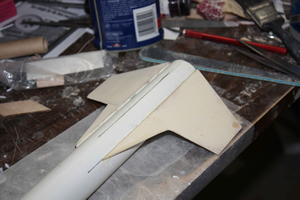
The attachment of the main fins to the body is an easy but delicate operation. The body tube was laid on a flat surface with the lug line in the 6 o'clock position. This put the two main fin lines on the top on either side of the noon position. The BT was then taped into place so that it would not roll. A double glue joint of yellow glue was built up on the fins and the BT and, with the second coat, the fins were put into place along their lines. They are intended to NOT be mounted perpendicularly but are supposed to droop so that the out edge is even with the bottom of the tube. Their position was checked from several different angles and then the assembly was left alone to dry. The groove formed by the fins and the tube was not an issue for reasons which will later be apparent.
The nacelle on the vertical tail is, like the other nacelles, made from a piece of BT20. Unlike the others,
though, it has a beveled trailing edge. This bevel is cut with the assistance of a wrap around template which was cut
out and wrapped around the tube. The tube was then placed on a mandrel and a razor knife was used to cut along the rear
edge. Sandpaper was used to clean up the cut.
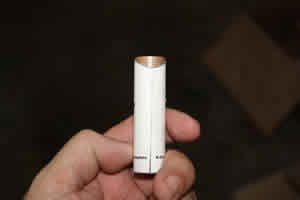
The main fins dried in place for a day before I risked disturbing them. When I picked the rocket up, the seemed to be attached about as well as could be expected for a joint that involved just the corner of one edge for the connection. This left a V-shaped valley on the dorsal surface between the fin and the BT. At least they seemed to be straight and Red River had a plan to fix the gap!
The kit came with a pair of wooden dowels the length of the fin root edges. These dowels were intended to fit into the gap between the BT and the fins. A batch of 5 minute epoxy was mixed and then some was brushed into the gaps. The dowels were pressed into the gaps and more epoxy was brushed over the top. I then used my finger whetted with some denatured alcohol to smooth out the epoxy and feather it to the BT and the fin.
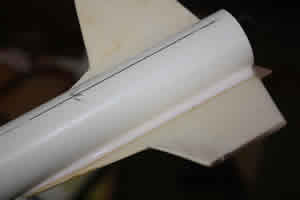
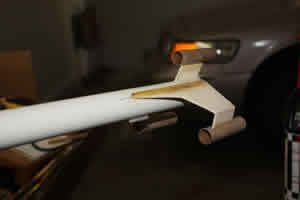
The balsa portion of the tail assembly is distinguished by being a single piece as opposed to the two similar pieces that go at the ends of the wings. It was glued in place along its marked line using a double glue joint.
When the glue on the tail had fully dried, I applied a fillet of Tightbond Trim and Molding glue to both sides. I also applied fillets to the undersides of the wings where the attached to the BTs. This was a big gap and I wanted to see if the Tightbond would work here. The results in both cases were excellent.
The vertical drops for the outer nacelles were affixed to the wings with 5 minute epoxy. It was important to ensure that the drops formed a right angle with the plane of the wings.
Again because of the shape and tightness of the finished shape, I went ahead and put Elmer's filler on the tail and the drops and allowed them a day to dry. The next day, these pieces were sanded down and particular attention was paid to where further glue joints would be made.
While the filler had been drying, I attended to a few small matters. The elastic was tied into the Kevlar®. The eye screw was twisted into the balsa cone, withdrawn and then seated again in a puddle of white glue.
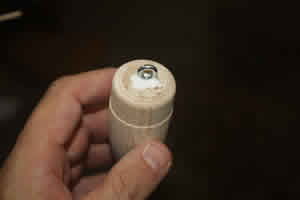
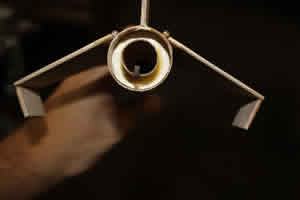
The tail nacelle, the one with the beveled cut, was glued to the tail piece with a double joint of yellow glue. It
was oriented so that the shortest part of the tube aligned with the stabilizer. The wing nacelles were likewise glued
to the vertical drops on the wings with a double joint with care being exercised that they were even. When the nacelles
had dried a bit, they were fillet with Tightbond Tim and Molding and the assembly was set aside to dry for a while.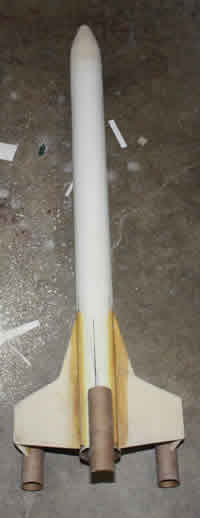
The nose cone was tied onto the elastic and then the shockcord was fed into the BT and the cone seated. The cone was then slathered with more Elmer's filler and allowed to dry. When it was dry, the cone was sanded and construction of the USS Prometheus was complete.
Finishing:
Filling and sanding of the Prometheus took place during the assembly. When the assembly was complete, the rocket was
taken to the booth and primed with Kilz.
A couple of days later, the Primed rocket was sanded down. It was at this point that I really began to appreciate the Tightbond Trim and Molding glue for fillets. There were no cavities.
After the sanding, the Prometheus was given 3 coats of glass white paint. I used the no-name generic Walmart paint which has done well for me in the past in both white and black.
The decals were nice waterslides. There were no specific instructions on their placement but the facecard provided all the information I needed. I started off with the three maroon rectangles. Two were located on either side of the tail assembly and the third was just in front of it. This was followed by the tail numbers, one on either side of the tail. I moved forward then with the name. Again, it was a pair, one on either side of the BT. I thought a nice touch to this kit was the colored pattern provided for the tail nacelle. This too was applied as a pair. The top surface got a long decal with some striping and some shapes which, I suppose, represent hatches. Both sides of the BT got a large, long decal representing windows.
Something I could not identify from the face card was the placement of the roundels. There were a pair of winged planets and a Red River Rocketry logo. I placed one of each on the upper wing surfaces, the Red River on the left and the planet on the right. I centered the other planetary roundel on the dorsal surface of the BT just ahead of the launch lug. It was at this point that I noticed that I had earlier cut out the "windshield" and had forgotten to place it so I did so on the nose cone. The last decal was a pair of stripes. I had not idea where they were supposed to go but I aligned them just forward of the planetery device on the ventral surface.

With that, the Prometheus was doomed sit around waiting for an opportunity to fly.
Construction Rating: 4 out of 5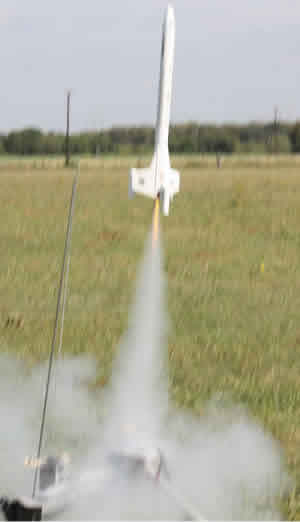
Flight:
I had to wait entirely too long after completing this model before having a chance to fly it and even then I only got
one shot at it due to time constraints. I installed a 12 nylon chute, stuffed in some dog barf on one end and a B6-4 on
the other and even had the presence of mind to make sure the windshield on the NC was oriented correctly and I finished
prepping and took it out to the pad.
Liftoff was fast, much faster than I expected. It went up without any weathercocking in what had become a
respectable breeze and stayed on a straight path all the way up. The ejection came just a touch early since the rocket
was still moving upwards. The chute ejected and it drifted down gently. There was no damage at all and it was ready to
fly again with the simple addition of another motor...but time ran out.
Flight Rating: 5 out of 5
Summary:
The Prometheus is a project that grew on me over time. I liked it well enough to begin with but, as it was built, I
began to appreciate it more and more. Seeing it perform just raised its status that much further. It is not a difficult
kit but does require some care. I suspect somebody could even make a go of it for their first rocket if they went
slowly and carefully read all the instructions. I don't recommend that but I do think its doable.
Overall Rating: 4 out of 5
Other:
Anyone interested in seeing what happens to this rocket can check it out here:
http://www.flickr.com/photos/23694991@N03/collections/72157622482462948/

Other Reviews
- Red River Rocketry Prometheus By James Gartrell (August 18, 2007)
Brief: The Prometheus is a relatively easy to build single stage rocket with a futuristic look. I got my kit from John as a beta test kit. The rocket is 21" in length, flies on 18mm motors, and recovers by parachute. The unique design and fantastic set of decals results in a model that looks fantastic on the launch pad. Another “not your normal” rocket from John! ...
 |
 |
Flights
Sponsored Ads
 |
 |











